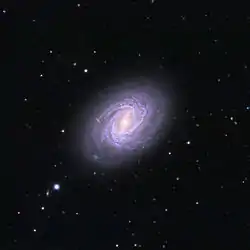NGC 7723
NGC 7723 is a barred spiral galaxy located in the constellation Aquarius. It is located at a distance of circa 90 million light years from Earth, which, given its apparent dimensions, means that NGC 7723 is about 95,000 light years across. It was discovered by William Herschel on November 27, 1785.[3] The galaxy is included in the Herschel 400 Catalogue. It lies 1.5 degrees north-northwest from Omega1 Aquarii. It can be seen with a 4-inch telescope under dark skies.[4]
| NGC 7723 | |
|---|---|
 NGC 7723 by Adam Block/Mount Lemmon SkyCenter | |
| Observation data (J2000 epoch) | |
| Constellation | Aquarius |
| Right ascension | 23h 38m 57.1s[1] |
| Declination | −12° 57′ 40″[1] |
| Redshift | 0.006254 ± 0.000027 [1] |
| Helio radial velocity | 1875 ± 8 km/s[1] |
| Distance | 91.5 ± 10.6 Mly (28.1 ± 3.3 Mpc)[1] |
| Apparent magnitude (V) | 11.2[2] |
| Characteristics | |
| Type | SB(r)b [1] |
| Apparent size (V) | 3′.5 × 2′.3[1] |
| Other designations | |
| MCG -02-60-005, PGC 72009[1] | |
Characteristics
NGC 7723 is a barred spiral galaxy. It has a bright nucleus and a boxy bulge.[5] In the centre of the galaxy lies a supermassive black hole whose mass is estimated to be (10.6±4.9)×106 M☉ based on the spiral arm pitch angle.[6] The bar emerges from the opposite sides of the bulge.[5] Straight dust lanes are observed along the bar, the one smooth and the other appearing broken.[7] The bar has a maximum apparent length 64 arcseconds. At the end of the bar the spiral arms form a pseudoring with diameter of 71 arcseconds.[8] Based on observations in far ultraviolet (FUV) and Hα there is active star formation at the pseudoring.[9] Based on the B-I color profile of the galaxy the bar finishes at 23 arcseconds, at the same distance where there is a population of older stars, and thus is suggested to be the corotation radius of NGC 7723.[10]
The structure of the arms is complex. The arm that emanates from the southwest part of the bar is well defined for a quarter of a revolution and after that it becomes more diffuse and fades after reaching half a revolution. The other arm emanates from a feature about 60 degrees northwest of the bar and brightens after passing the end of the bar, and then it splits in two. The inner part forms the southwest part of the pseudoring and bifurcates after winding for about 120 degrees after the bar end, with the inner part being the brightest. The other arm becomes diffuse and of low surface brightness.[5]
One supernova has been observed in NGC 7723, SN 1975N, a type Ia supernova with peak magnitude of 13.8.[11]
Nearby galaxies
NGC 7723 belongs to a small groups of galaxies known as the NGC 7727 group. Other members of the group include NGC 7727 and NGC 7724.[12] NGC 7727 lies about 40' northwest of NGC 7723.[7]
References
- "NASA/IPAC Extragalactic Database". Results for NGC 7723. Retrieved 2016-01-18.
- "Revised NGC Data for NGC 7723". spider.seds.org. Retrieved 25 November 2018.
- Seligman, Courtney. "NGC 7723 (= PGC 72009)". Celestial Atlas. Retrieved 19 November 2018.
- O'Meara, Steve (2007). Steve O'Meara's Herschel 400 observing guide : how to find and explore 400 star clusters, nebulae, and galaxies discovered by William and Caroline Herschel. Cambridge: Cambridge university press. p. 285. ISBN 978-0521858939.
- Eskridge, Paul B.; Frogel, Jay A.; Pogge, Richard W.; Quillen, Alice C.; Berlind, Andreas A.; Davies, Roger L.; DePoy, D. L.; Gilbert, Karoline M.; Houdashelt, Mark L.; Kuchinski, Leslie E.; Ramirez, Solange V.; Sellgren, K.; Stutz, Amelia; Terndrup, Donald M.; Tiede, Glenn P. (November 2002). "Near‐Infrared and Optical Morphology of Spiral Galaxies". The Astrophysical Journal Supplement Series. 143 (1): 73–111. arXiv:astro-ph/0206320. Bibcode:2002ApJS..143...73E. doi:10.1086/342340. S2CID 15491635.
- Treuthardt, Patrick; Seigar, Marc S.; Sierra, Amber D.; Al-Baidhany, Ismaeel; Salo, Heikki; Kennefick, Daniel; Kennefick, Julia; Lacy, Claud H. S. (11 July 2012). "On the link between central black holes, bar dynamics and dark matter haloes in spiral galaxies". Monthly Notices of the Royal Astronomical Society. 423 (4): 3118–3133. arXiv:1204.4210. Bibcode:2012MNRAS.423.3118T. doi:10.1111/j.1365-2966.2012.21118.x. S2CID 118989396.
- Sandage, A., Bedke, J. (1994), The Carnegie Atlas of Galaxies. Volume I, Carnegie Institution of Washington
- Comerón, S.; Salo, H.; Laurikainen, E.; Knapen, J. H.; Buta, R. J.; Herrera-Endoqui, M.; Laine, J.; Holwerda, B. W.; Sheth, K.; Regan, M. W.; Hinz, J. L.; Muñoz-Mateos, J. C.; Gil de Paz, A.; Menéndez-Delmestre, K.; Seibert, M.; Mizusawa, T.; Kim, T.; Erroz-Ferrer, S.; Gadotti, D. A.; Athanassoula, E.; Bosma, A.; Ho, L. C. (19 February 2014). "ARRAKIS: atlas of resonance rings as known in the S4G". Astronomy & Astrophysics. 562: A121. arXiv:1312.0866. Bibcode:2014A&A...562A.121C. doi:10.1051/0004-6361/201321633. S2CID 119295831.
- Comerón, S. (9 July 2013). "Inner rings in disc galaxies: dead or alive". Astronomy & Astrophysics. 555: L4. arXiv:1306.4515. Bibcode:2013A&A...555L...4C. doi:10.1051/0004-6361/201321983. S2CID 56144824.
- Aguerri, J. A. L.; Muñoz-Tuñón, C.; Varela, A. M.; Prieto, M. (September 2000). "Characterizing bar structures: application to NGC 1300, NGC 7479 and NGC 7723". Astronomy and Astrophysics. 361: 841–849. Bibcode:2000A&A...361..841A.
- List of Supernovae IAU Central Bureau for Astronomical Telegrams. Retrieved 29 December 2015.
- Makarov, Dmitry; Karachentsev, Igor (21 April 2011). "Galaxy groups and clouds in the local (z∼ 0.01) Universe". Monthly Notices of the Royal Astronomical Society. 412 (4): 2498–2520. arXiv:1011.6277. Bibcode:2011MNRAS.412.2498M. doi:10.1111/j.1365-2966.2010.18071.x. S2CID 119194025.
External links
| Wikimedia Commons has media related to NGC 7723. |
- NGC 7723 on WikiSky: DSS2, SDSS, GALEX, IRAS, Hydrogen α, X-Ray, Astrophoto, Sky Map, Articles and images
